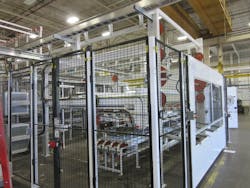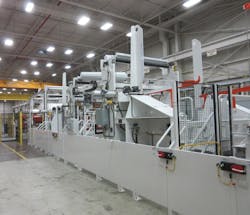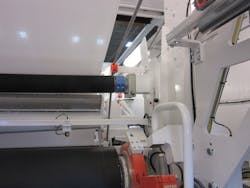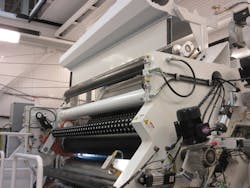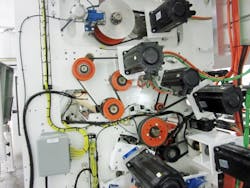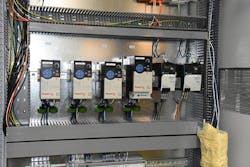Case Study: How PCMC makes functional safety an integral part of its equipment
Safety is a critical factor across the industrial landscape. But while reducing risk on the plant floor has been a constant for more than a century, safety standards have undergone a global transformation in recent years.
“In the converting industry, the changes have been extraordinary,” says Jill Thiede, strategic accounts manager, Paper Converting Machine Company (PCMC) in Green Bay, Wisconsin. “Today, our focus is twofold: making equipment that runs 3,000 ft/min more efficient and enhancing the safety of that equipment.”
To meet this challenge, PCMC, a Barry-Wehmiller company, makes functional safety an integral part of the design process across its portfolio and in upgrades that support legacy equipment (Figure 1).
"Safety has always been an important part of our equipment," says Jason Stover, senior electrical project engineer at PCMC. "However, in the past six years, we have really made some improvements in that area. Ten years ago, we of course had safety on our equipment, but it was what we thought was the best for safety. As we progressed, customers would ask safety questions, and it would be difficult to substantiate our viewpoint. It was one of the challenges we faced."
Figure 1: PCMC, a Barry-Wehmiller company, makes functional safety an integral part of the design process across its portfolio.
Source: PCMC
Figure 2: A machine was designed first, and guarding and other safety components were applied later.
Source: PCMC
Because of this, over the past several years, PCMC worked with Rockwell Automation to utilize industry safety standards as the backbone of its equipment. "Now when the customer asks us safety questions, we can clearly articulate why we implemented safety design the way we did, and it is clearly documented," notes Stover. "It's no longer a discussion of whether it is right or wrong, but more of system functionality, which is a lot easier. We know why we do what we do when it comes to safety, which is much better than being in a position where you are not sure of the answer."
Running with safety
With almost 100 years of experience, PCMC designs, builds and services machinery for the tissue-converting, packaging, flexographic-printing and nonwovens industries. Its installed base has an active equipment life that can extend beyond 50 years.
For decades, machine builders approached safety as an add-on. A machine was designed first, and guarding and other safety components were applied later (Figure 2). Still prevalent today, this method enables an OEM to achieve safety compliance, but often at the cost of productivity.
“These installations meet regulations, but oftentimes the entire machine must be stopped to changeover the equipment or perform maintenance,” says Stover.
Also read: How technology is making machines safer
Contemporary functional safety standards, including IEC 62061 and ISO 13849-1, plus the latest control and software capabilities, enable OEMs to design safety into machinery.
“It’s really a change in philosophy,” says Thiede. “Now, we can design an integrated safety system that reduces machine hazards and associated risks and improves overall efficiency and productivity.”
For example, PCMC can divide a complex converting line into safety zones corresponding to specific risks, hazards or functions. The system can be configured to safely remove power and allow maintenance in one zone, while keeping the rest of the line up and running.
"With our equipment , we also design for a fast stop; it's faster than a normal stop, but it is not as fast as an emergency stop," says Stover. "We have normal, fast and e-stop types of stops on our machines. Most of our equipment has guarding around it with locking guard switches (Figure 3). We lock doors and only unlock when zero speed is detected because, if someone opens a guard with the equipment running, it won't stop fast enough. The operator could reach the hazard before it stops, so it must be locked."
PCMC rarely uses light curtains because of the large inertial loads present. "Only in a few cases is the light curtain or laser area scanner a solution," states Stover. "It works with indexing and in-and-out-type applications in some of our printing equipment, for example, but not in rotational motion applications. Rotation hazards often don't stop fast enough."
Figure 3: If someone opens a guard with the equipment running, it won't stop fast enough. The operator could reach the hazard before it stops, so it must be locked.
Source: PCMC
Converting safety challenges
"PCMC designs and builds a variety of machine types, but a common changeover is replacing an empty parent roll," says Stover. "Traditionally the equipment would need to be stopped, the empty roll removed and the new roll installed and spliced with the downstream web. To improve efficiency, the roll can be replaced with the machine running, which exposes the operator to hazards."
Just moving the roll, which can be 120-130 in wide, 6-8 ft diameter and weigh 10,000 lb, poses a hazard for operator safety (Figure 4). PCMC designs safety into the equipment by moving the roll automatically after manually staging it in a prep area. With the roll staged, the operator can exit the hazardous area, reducing safety risks.
"Thread-up can be a big hazard with converting equipment," notes Stover. "It can be a struggle. Automated systems for thread-up are not easy or convenient. The operator needs to be part of the process to bring the web from the parent roll and threaded through the machine (Figure 5). Now, being able to use some of the safety technology such as safety PLCs , safe speed and safe off, we can ensure only the areas of the machine that need to be running are running. We can also ensure that they are running at a speed that will not produce a hazard for the operator. This is a big key to safety for us—multiple safety zones with safety functionality changing depending on operator location and machine functional state."
Figure 4: Moving the roll, which can be 120-130 in wide, 6-8 ft diameter and weigh 10,000 lb, poses a hazard for operator safety.
Source: PCMC
Figure 5: The operator needs to be part of the process to bring the web from the parent roll and threaded through the machine
Source: PCMC
Another big area for PCMC is flexographic printing. "Printing of inks today often has shorter runs, which means lots of ink changeover," comments Stover. "A large percentage of the downtime is in the changeover process. From a safety standpoint, we need to be able to isolate a single ink roll for changeover or cleaning. We then look for ways the operator can be cleaning the roll while the next job is running. A flexible safety system and safety sensors makes this possible and safe, improving machine efficiency.”
Safe control
To achieve safety functionality, the PCMC equipment is built on a Rockwell Automation integrated safety solution based on the Allen-Bradley Logix control platform, mostly ControlLogix. Depending on the application, the machinery can also include Allen-Bradley Kinetix 6500 servo drives for coordinated drive control and Allen-Bradley PowerFlex 525, 755 and 70 ac drives for variable speed control.
The Kinetix and PowerFlex drives include built-in safety functionality via the safe-torque-off (STO) feature. STO capability removes rotational power from the motor without powering down the entire machine (Figure 6). The machine is safer when it is stopped and can be restarted more quickly. The robust safety solution also incorporates Point Guard I/O and other safety-rated components.
There are many parts to safety in converting equipment. "Axis counts on our machines range from three axes on our small systems to high-end equipment with 40 coordinated axes," states Stover. "We use multiple Allen-Bradley ControlLogix controllers in a rack to handle the axes, and Allen-Bradley's new L8 processor is much faster and supports up to 256 axes of integrated motion, which will help with high axis counts. One of our printing machines has up to 87 axes for motion, setup and adjustment, and all of the axes are connected into the same safety system."
Motion control
PCMC's basic sectionalized drive system uses coordinated motion through gearing. "Typically gearing and virtual axes will be used to help with coordination and control of the axes," says Stover. "Many of our product lines are based on motion profiles, which are synced to the sectionalized drive system. It's used on our motion-profile, time-based systems where a master-follower-type relationship is required, such as tissue converting of a large roll into multiple individual rolls, wound and cut to size. The continuous process including winding, cut-off and transfer of the next roll must be time-based."
Figure 6: STO capability removes rotational power from the motor without powering down the entire machine.
Source: PCMC
Most of the sectionalized drives in PCMC's equipment utilize VFDs. "With Rockwell Automation's CIP technology—deterministic, real-time, closed-loop motion control over Ethernet—all axes are run using position control mode," comments Stover. "All of the motors on the equipment basically act as servos, versus a typical VFD motor with just speed control. We achieve near-servo performance out of the motors. The variable frequency drives are controlled with the same motion commands as the servos when using Allen-Bradley's PowerFlex 755 technology."
Rockwell's CIP technology helped with PCMC's motion setup. "We can use the same code that the servos do," states Stover. "This simplified our control architecture, as well as our communication architecture, to just be able to control all the motors with the same set of commands and programming, whether servo motors or VFDs are used."
The PowerFlex 525 and 70 ac drives are used for basic variable speed control for ancillary functions such as ink and adhesive pumps, fluid pumps and conveyor systems (Figure 7). "Regardless of the drive used, we utilize the safe off functionality built in to device," notes Stover.
PCMC applies Allen-Bradley PanelView Plus 6 graphic terminals for local monitoring and an industrial computer running FactoryTalk View human-machine interface (HMI) software at the main console or in the control room. The system is typically integrated on an EtherNet/IP network.
"EtherNet/IP is used almost exclusively to tie all the hardware together," notes Stover. "Due to the number of servo motors, we pay careful attention to motion precision time protocol (PTP). We need to be careful with our choice of architecture and choice of Ethernet switches. We need to treat motion and safety differently from the peer-to-peer communication such as HMI and I/O. It's all part of our integrated design. We don't just go and buy low-cost, off-the-shelf Ethernet switches. We utilize the proper gear such as Rockwell Automation Stratix switch-technology hardware to ensure high availability and data integrity. We also have engineers who have completed Cisco training to ensure our equipment meets the demands of the application."
Figure 7: Drives are used for basic variable speed control for ancillary functions, such as ink and adhesive pumps, fluid pumps and conveyor systems.
Source: Rockwell Automation
The path to safety
In any installation, PCMC follows a rigorous, systematic design process that includes defining functional safety requirements early on and verifying and validating the safety system when it is complete.
“Our process begins with a risk assessment, which helps to define which hazards are present and what we can do about it,” Stover explains. “First and foremost, we design the hazard out of the machine, if at all possible. If we can’t design it out, we look at protective measures that can reduce risk.”
PCMC believes the need for thorough validation and documentation has increased as safety control architectures have become more robust. “In an old hardwired system, you could easily see the safety functionality in an electrical schematic,” Stover says. “Now, much of that functionality is hidden within the programming of the safety controller. Proper documentation is essential to enable the validation of any future enhancements to the system.”
PCMC created its own safety requirement specification (SRS). "From our risk assessment, we add what the safety functions are to our SRS per ISO 13849-1,” states Stover. "We also use the safety integrity software tool for the evaluation of machine applications (SISTEMA) to evaluate machine safety. It helps us to verify that we meet the appropriate safety level in our design. We give this information to our customers, also."
The SRS is used as a checklist to verify all the machine safety functions. Rockwell also has many great documents on how to test safety that PCMC uses, such as data for Rockwell Automation machinery safety products available in the form of a library file to be used with the SISTEMA calculation tool.
"We combine the bulleted list of safety tests, Rockwell's recommendations and our internal standards into the SRS and test the equipment," states Stover. "It reduces our paper requirements. It is how we keep our engineers innovating instead of filling out paperwork, and it keeps us efficient when meeting the always important safety requirements."
Training and the future
PCMC provides its customers with safety documentation during equipment installation and also electronically stores the documents to support PCMC equipment throughout its lifecycle. All PCMC engineers are thoroughly trained on machine safety, and, in addition, the company employs a dedicated safety engineer. PCMC also offers machine safety training as part of its aftermarket services.
“As control systems evolve, we will continue to call on Rockwell Automation functional safety experts to complement our in-house expertise,” says Stover. “We feel we are well-positioned to evolve our design philosophy in line with regulatory requirements and advances in technology.”
PCMC sees a future with integrated safety. "We can operate the machinery safely, but safety is not a hindrance any more,” says Stover. “With the newest technology, it is easier to do the validation of drives and safety devices, even from the assembly side. They will be connected on a CIP safety network. It will just be a plug-in scenario which makes for quicker and more robust assembly and wiring. Instead of a bunch of wires, it's just one cable."
PCMC is ready for more safety over communication links instead of hardwire. "Once safety is moved to the communication links, instead of easily viewable in hardware drawings, the onus is on the OEM to provide the confidence that the machine is designed safely, and that is through our documentation and testing. We have that covered as we know why we do what we do when it comes to safety."
About the Author

Dave Perkon
Technical Editor
Dave Perkon is contributing editor for Control Design. He has engineered and managed automation projects for Fortune 500 companies in the medical, automotive, semiconductor, defense and solar industries.

Leaders relevant to this article:



